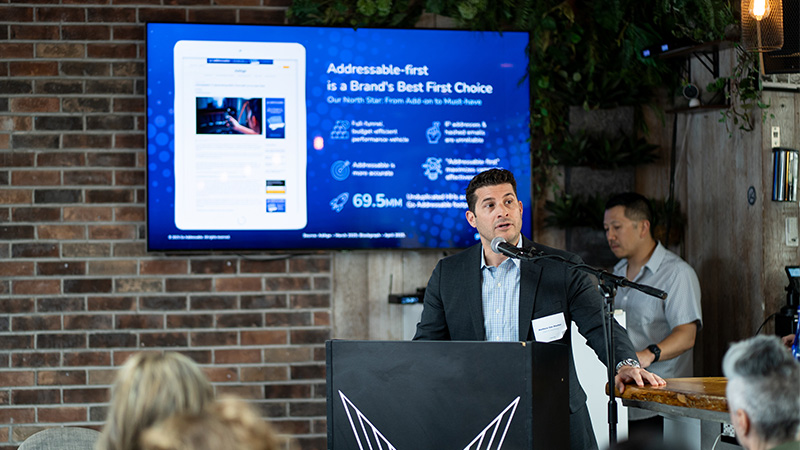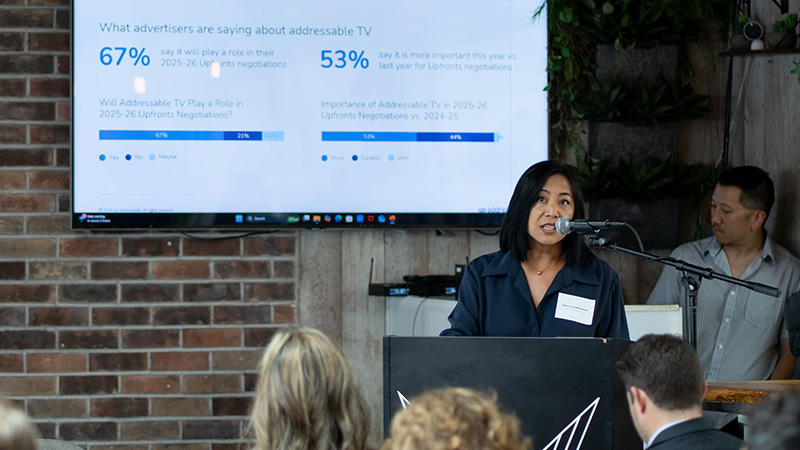At Go Addressable, our mission is to accelerate the advancement of addressable TV advertising — and the 2025 TV Upfronts Brunch reinforced why going addressable-first is a smart choice for brands. On May 15, we welcomed more than 100 industry partners for an event that went beyond showcasing inventory — it redefined the critical role of addressability — the scalable use of first-party deterministic data — within the broader TV advertising landscape.
Featuring insights from leaders across media, technology, and agencies, the program encouraged a deeper conversation around the state of addressable in today’s marketplace — and how it’s continuing to grow. It also introduced a forward-looking perspective: that addressable should no longer be an add-on, but rather a strategic starting point in the planning process.
Here’s a look back at the ideas and moments that defined the day.
Kicking Off with New Momentum

Speaker: Matthew Van Houten, Go Addressable & DIRECTV Advertising
Go Addressable’s 2025 Board Chair, Matthew Van Houten of DIRECTV Advertising set the tone by highlighting addressable’s current state: delivering unduplicated reach, incredible efficiencies and measurable outcomes, all at scale with 69.5MM households across the Go Addressable footprint.
And that momentum is growing! New Go Addressable members were announced, including Adobe, Ampersand, Basis Technologies, Hearst Television, INVIDI Technologies, and iSpot, expanding the trade organization’s influence and signaling widespread industry alignment.
Newly released stats from the latest Advertiser Perceptions report showed:
- 67% of advertisers say addressable TV will play a role in the 2025/26 TV Upfront negotiations
- 53% of advertisers, say that addressable TV will be an even more important part of this year’s Upfront negotiations compared to 2024
- 80% of advertisers say they’re using or planning to use addressable in 2025
Buyers are driving the effort, with 44% of advertisers currently planning with addressable-first strategies. The day’s discussions focused on empowering agencies to help their clients bridge the gap between intention and execution. While advertisers increasingly recognize the value of addressable TV, the event encouraged the industry to put it at the forefront of planning, prioritizing addressable as a foundational element of video strategy.
A New Map for a Data-Driven World

Keynote Speaker: Evan Shapīro, ESHAP TV
Known for his sharp wit and sharper data visualizations, Evan Shapīro delivered a keynote entitled “Public Addressable: Why The Best Data Wins” focused on the power of deterministic data and its essential role in addressable TV advertising. He unveiled a new industry cartography structuring the media ecosystem through a new lens: The Addressable Table of Elements. This visualization illustrates the extensive number of companies that support the 69.5 million unduplicated households across the Go Addressable footprint, highlighting the superior offerings for those using deterministic data. The chart categorized companies based on their level of deterministic data, providing a clear view of which sources are most reliable when it comes to targeting households effectively.
Shapīro made a compelling case for why deterministic data is crucial for effective ad planning. Shapīro contrasted it with the challenges of using IP address data, which lacks a standardized measure for accuracy and quality. A typical vendor has an average of 4 different IP addresses per household whereas the ISP providers only show about 1.3, leading to a significant amount of waste, as many IP addresses do not match the target household.
By comparison, Shapīro highlighted how providers like DIRECTV, DISH, Comcast, and Charter deliver a wealth of high-quality, deterministic data, such as active email addresses, credit card information, and household-level details. When this data is anonymized and processed in a clean room, it allows advertisers to more accurately identify their target audiences, leading to more efficient and effective ad buys.
“Starting with deterministic data and building from there, you begin with a solid foundation of quality household-level data, with real human beings watching TVs in their homes,” Shapīro explained. “That’s the starting point, and from there, you can build your strategy.”
Shapīro emphasized that while content has long been considered king in the advertising world, data is now the bloodline — the driving force behind every advertising decision. Outcomes are now the key metric for success, and advertisers must focus on the tangible impact their ads have on driving transactions. This is where addressable advertising excels, offering a much clearer picture of campaign performance before, during, and after the campaign, allowing advertisers to measure the real return on investment (ROI).
“Outcomes are the new black,” Shapīro stated. “It’s no longer just about the impressions you buy, but whether or not those impressions drive a meaningful transaction.”
Finally, Shapīro addressed an emerging challenge: churn. With the rapid growth of streaming platforms and changing consumer behaviors, advertisers must ensure they are reaching the right audience in a way that minimizes waste. As he put it, “If content is king, churn is the big problem. You have to go where you know impressions are being met.”
It’s Time to Flip the Script on Media Planning
Upfront Presentation: Addressable TV 2025: Planning with Addressable-First Strategies

Speaker: Dawn Lee Williamson, Comcast Advertising
Dawn Lee Williamson of Comcast Advertising took the stage with a clear message: “Today we’re here to explain why we need to flip the script: Addressable should be the starting point, not the afterthought.”
Williamson made the case that addressable TV has evolved far beyond its origins as a niche or supplementary tactic. It’s now the most efficient, effective, and scalable way to reach audiences across screens. With its precision and performance, addressable is redefining the role of television in the media mix — from a top-of-funnel awareness tool to a full-funnel solution that drives real business outcomes.
Efficiency and Cost-Effectiveness at Scale
Addressable’s ability to deliver results across multiscreen environments is unmatched. Williamson highlighted that, based on Comcast Advertising’s internal research, campaigns planned with addressable strategies often yield eCPMs up to 50% lower than those relying on non-addressable streaming or digital buys.
Williamson echoed Shapīro’s earlier remarks, highlighting the power of deterministic data over probabilistic models. Advertisers are better served by accurate identity data than imprecise signals like IP addresses or hashed emails. Addressable advertising offers better targeting, better control over frequency, and far less waste.
Better Match Rates, Better Results
One of the strongest arguments for addressable-first planning lies in the quality of identity matching. Williamson shared compelling stats to support this:
- 95% of addressable households are matched using postal addresses, compared to just 60% when using IP data
- After 30 days, 82% of addressable households remain accurately matched, while that number drops to 44% on CTV platforms using probabilistic data
This stability in identity resolution helps advertisers reduce wasted impressions and increase the likelihood of reaching real, engaged consumers in real households.
From Awareness to Action
Addressable is no longer just about reaching viewers — it’s about moving them to action. With the right strategy and data, advertisers can now deliver campaigns that are measurable at every stage of the funnel.
“It used to be that TV was just for brand development,” Williamson said. “Now, with addressable, it’s a full-funnel solution — from awareness to conversion.”
By starting with addressable in the planning process, advertisers gain the ability to better control frequency, optimize spend, and directly tie their media investment to business outcomes.
Buyers Shift Gears: Addressable Moves from Niche to Necessity
Panel: Why Now is the Time to Lead with Addressable

Moderator: Kerry Flynn, Axios
Panelists: Dave Antonelli, DISH Media; Ashley Arena, PHD; Lisa Herdman, RPA; Kevin Weigand, dentsu
The buy-side panel brought the event’s central message into sharp focus: addressable TV is no longer emerging — it’s arrived, and leading buyers are already rethinking how it fits into the core of their video strategies.
With representation across agency, brand, and media platforms, the panelists spoke to the growing confidence in addressable TV advertising and its evolution from a niche tactic to a foundational performance channel. One theme echoed throughout: outcomes now drive decision-making, and addressable is uniquely positioned to deliver them.
Data Avoidance Becomes Data-Driven
Lisa Herdman of RPA reflected on just how far the industry has come when it comes to TV and data.
“Addressable is not new to many of us — it’s the OG: linear television with data.”
Not long ago, clients were hesitant to engage in conversations about data when it came to television. The idea of applying digital-style targeting and measurement to traditional TV was often met with resistance or confusion. But that’s changed — dramatically.
Today, with video becoming increasingly data-driven and full-funnel strategies gaining traction, those same conversations are becoming standard. Data is no longer a barrier to TV planning; it’s the bridge. And addressable TV, once considered a nice-to-have, is now taking center stage.
Outcomes, Not Just Impressions
For Ashley Arena of PHD, the discussion reinforced a larger trend:
“Everything we’re talking about in the video space is about how the funnel has collapsed. It’s not just about reach anymore — it’s about reaching the right consumers and driving real business results.”
Arena emphasized the importance of putting outcomes first, leveraging technology and data to move beyond traditional reach metrics and focus on actual performance — a shift that addressable enables in ways other channels cannot.
Dave Antonelli of DISH Media agreed, noting that this increasing focus on measurable outcomes is a major factor accelerating addressable adoption across the board.
The eCPM Case Is Clear
The most referenced insight shared during the buy-side panel was the role of effective CPM (eCPM) analysis in demonstrating the true value of addressable advertising. While addressable CPMs can sometimes appear higher at face value, panelists emphasized that precision targeting, reduced waste, and stronger match rates often result in far more efficient outcomes when you calculate what you’re actually paying for.
As Dave Antonelli of DISH Media put it:
“The idea that addressable is expensive is old news, It’s not true. We see the stats that show the effective CPM is much more efficient, much more effective, not wasting your budgets.”
TV as a Performance Tactic
Kevin Weigand of dentsu shared that TV is increasingly being viewed through a performance lens — an exciting shift for both agencies and clients. With advancements in programmatic capabilities across both linear and CTV addressable environments, clients are beginning to see TV not just as a reach or branding tool, but as a measurable, performance-driven tactic. Many now use addressable as their entry point into national video buys, drawn by its ability to deliver targeted results and actionable insights.
Best Practices for Buyers: A Playbook for Progress
The panel also offered practical guidance for marketers and buyers looking to deepen their addressable strategies:
- Prioritize audience, not just demos: Addressable allows for precise audience-based buying, unlocking more relevant engagement.
- Build measurement into the plan: Develop a clear measurement strategy before making investment decisions.
- Conduct eCPM analysis: Comparing effective CPMs can surface surprising efficiencies and value-adds in addressable buys.
- Start with objectives: Define business goals first, then plan backwards to media execution.
- Never stop learning: The landscape is shifting quickly. “Educate, educate, educate” was a rallying cry from the panel — understanding the evolving ecosystem is essential to success.
As the session closed, it was clear that the question is no longer if addressable should play a central role, but how soon brands and agencies can adjust to lead with it.
Looking Ahead: A Smarter, More Precise Ecosystem

Closing Speaker: Dan Callahan, Spectrum Reach
To close out the event, Dan Callahan of Spectrum Reach shared a forward-looking vision for the next phase of Go Addressable. His remarks highlighted the organization’s continued focus on education, innovation, and measurement — three pillars that will shape the future of addressable advertising. He highlighted the continued need for clarity, consistency, and education as addressable TV matures.
What’s Coming Next from Go Addressable
Callahan announced a new initiative in partnership with Truthset, aimed at bringing more transparency and accountability to the industry’s data infrastructure. The upcoming study will evaluate the accuracy of IP-to-household address mapping across a variety of identity graphs. The goal: to better understand how precise identity resolution impacts targeting performance and campaign measurement. As deterministic data becomes central to addressable’s value proposition, this research will help validate and improve the data standards the industry relies on.
Go Addressable is making a firm commitment to industry education. Callahan revealed that the organization is launching a dedicated education curriculum designed to equip media decision-makers with the tools and knowledge they need to confidently plan, buy, and execute addressable TV campaigns. This curriculum will serve as both a practical resource and a long-term effort to grow industry fluency in addressable — ensuring that adoption continues to rise with understanding and experience.
Finally, Callahan reminded attendees to mark their calendars: the Go Addressable Summit will return in November 2025 for its fifth annual event, offering another opportunity for the industry to come together, share best practices, and chart the future of addressable TV advertising.
Conclusion: From Emerging Trend to Strategic Priority
The 2025 Go Addressable Upfront Brunch was more than just a gathering — it marked a milestone: addressable TV has moved beyond early adoption and is now a core part of the TV advertising landscape. The infrastructure is in place, the data is more precise, and the measurement has matured. Most notably, media buyers are engaging with greater urgency and confidence, signaling that addressable is no longer optional — it’s essential.
So the real question is no longer why addressable?
It’s why not start with it?
See you at the Summit in November.